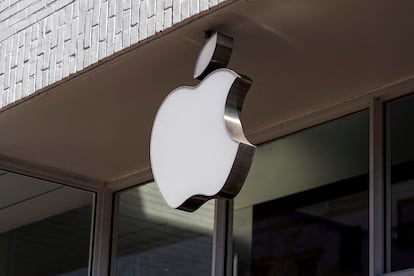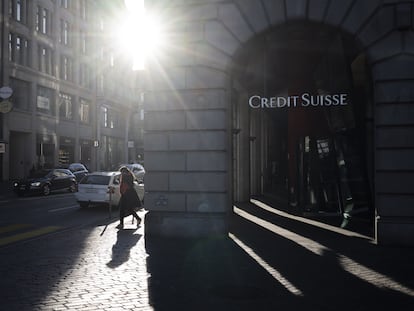Apple puts pressure on US banking sector by offering higher rate of return
The technological giant – with almost infinite commercial and financial capacity – has made a big play in the financial services sector at a critical moment

Apple has launched a savings account offering a 4.15% interest rate – four times the average annual return of an American account. The technology giant launched this offer when the markets still haven’t recovered from the turmoil caused by the collapse of Silicon Valley Bank. This puts even more pressure on the legacy financial sector in the United States, with nervous clients looking to withdraw their money and place it elsewhere at the slightest hint of instability – and at any sign of a better deal.
In March, smaller banks in the United States lost $175 billion in deposits, according to data from the Federal Reserve. And, in the first two weeks of April, they lost another $50 billion, representing a total decrease of 4% in deposits in less than two months. With the fall of Silicon Valley Bank, analysts and media outlets have pointed out the concentration of major businesses in a handful of financial institutions. These firms have the ability to pull out larger sums at a faster rate than individual depositors. With technology today, it’s possible to open a new bank account and transfer your cash in a matter of seconds.
First Republic lost 40% of its deposits in the past three months of this year – about $100 billion. In that same period, deposits at Charles Schwab fell by 11%, while this past Monday, Credit Suisse announced $68 billion in lost deposits in the first quarter of 2023. The Swiss firm is the best example of how a sufficiently serious liquidity crisis can affect even a top-tier entity. Alarm bells are going off in the financial sector, with dwindling customer loyalty in a context of competitive interest rates and global instability. In the past, big banks usually benefited from this situation, but this could be changing.
Until now, traditional firms experienced competition from so-called neobanks or fintech. However, many of these platforms have typically been oriented towards payments, investment or the provision of consultations, initiatives more designed to complement banking services, rather than compete with them directly. Before offering its new savings account, Apple was already engaged in these kinds of activities.
The payment sector tends to be relatively open to innovation. According to the latest survey on the use of cash from the Bank of Spain, in 2022, about 19% of users made payments with their mobile devices. For users between the ages of 18 and 24, about 23% of customers made mobile payments on a daily basis – just nine points less than the daily use of a credit card.
The great paradox for traditional banking is no different from that of other traditional activities whose business model has been torpedoed by a technology that offers a much cheaper alternative. If these banks continue their traditional activity, they risk becoming obsolete. But if they get too close to the new business models, they run the risk of offering the user a product that is too similar to competitors, but more expensive.
It’s one thing to use a credit card to make a payment, or use an app to speed up payroll or request a quick credit increase. It’s quite another task to deposit savings. In this sense, Apple’s approach is key, because it has two assets that – in the eyes of the user – newly minted entities don’t. Apple is one of the most renowned brands in the world and it has the financial strength of a nuclear bunker in the Cold War. Both elements break the great entry barrier in banking: customer trust. A barrier that the company has managed to turn into an advantage, now marketing everything from funds to insurance, with juicy returns.
Apple Inc. also has an advantage from three other angles: the easy user experience it offers, its ability to distribute services via an almost infinite distribution channel and its possession of an archive of customer data that is larger than any other company. Just to point to one statistic: currently, there are 1.2 billion iPhones in use on the planet.
“It may not have guaranteed (insured) deposits, but it is a bank. If it moves money, guards it, manages it and lends it, it’s a bank,” JP Morgan chief executive Jamie Dimon said last year about Apple. It’s not the first time that he refers to his competition. The company – without the need for major advertising – already offers Apple Pay (a payment service), Apple Pay Later (a cash advance service), Apple Card (its own credit card) and Apple Cash (a money transfer service). All of these initiatives are integrated within the Apple ecosystem… as is Apple Savings. The company doesn’t offer details regardings its income from financial service, but it is estimated that subscriptions and income from the iOS ecosytem make up about a fifth of Apple’s total profit.
It’s true that the company doesn’t operate as a bank, doesn’t have a banking record and isn’t subjected to the regulations of the sector. But Apple Savings launched hand-in-hand with Goldman Sachs, with whom the company has already launched Apple Card. This partnership with one of the largest and most-known investment banks – along with the high returns being offered by the new savings accounts – is a means of gaining customers and market share. It remains to be seen what the result will be in the traditional commercial banking sector.
Sign up for our weekly newsletter to get more English-language news coverage from EL PAÍS USA Edition
Tu suscripción se está usando en otro dispositivo
¿Quieres añadir otro usuario a tu suscripción?
Si continúas leyendo en este dispositivo, no se podrá leer en el otro.
FlechaTu suscripción se está usando en otro dispositivo y solo puedes acceder a EL PAÍS desde un dispositivo a la vez.
Si quieres compartir tu cuenta, cambia tu suscripción a la modalidad Premium, así podrás añadir otro usuario. Cada uno accederá con su propia cuenta de email, lo que os permitirá personalizar vuestra experiencia en EL PAÍS.
¿Tienes una suscripción de empresa? Accede aquí para contratar más cuentas.
En el caso de no saber quién está usando tu cuenta, te recomendamos cambiar tu contraseña aquí.
Si decides continuar compartiendo tu cuenta, este mensaje se mostrará en tu dispositivo y en el de la otra persona que está usando tu cuenta de forma indefinida, afectando a tu experiencia de lectura. Puedes consultar aquí los términos y condiciones de la suscripción digital.
More information
Archived In
Últimas noticias
Tiger Woods turns 50: Will he continue playing on the PGA Tour or take a back seat?
The surreal journey of James Nnaji, the Barcelona youth player selected in the NBA Draft who ended up in the NCAA
Trump claims peace in Ukraine is near, but Moscow suggests otherwise
A survivor’s account of the Interoceanic Train accident: ‘We were scared because of the speed on the curve’
Most viewed
- Oona Chaplin: ‘I told James Cameron that I was living in a treehouse and starting a permaculture project with a friend’
- Reinhard Genzel, Nobel laureate in physics: ‘One-minute videos will never give you the truth’
- Why the price of coffee has skyrocketed: from Brazilian plantations to specialty coffee houses
- Pablo Escobar’s hippos: A serious environmental problem, 40 years on
- Chevy Chase, the beloved comedian who was a monster off camera: ‘Not everyone hated him, just the people who’ve worked with him’











































